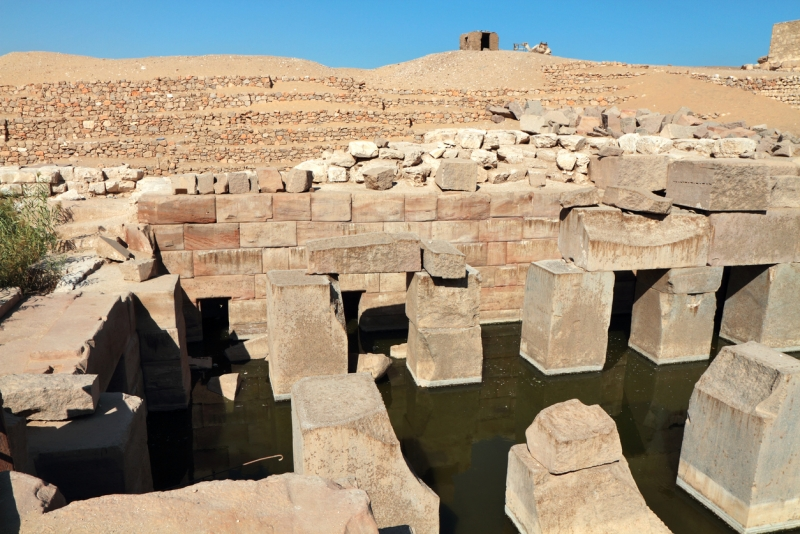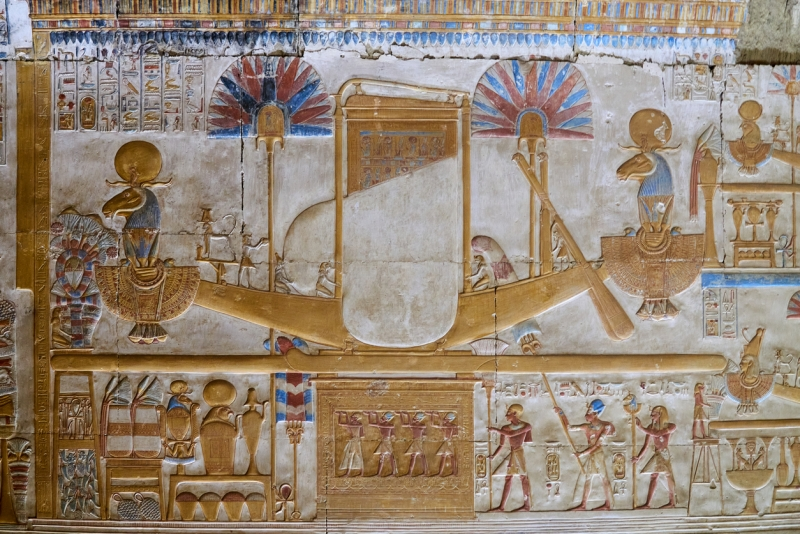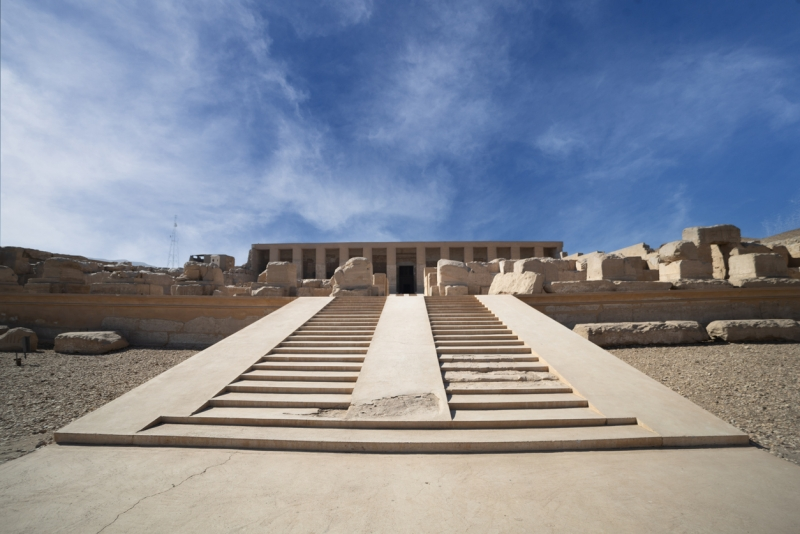Temple of Abydos (Temple of Seti I)

The Temple of Seti I is a significant ancient Egyptian temple from the 13th century BC, located in Abydos, Upper Egypt. Built of limestone and sandstone, it is known for its unique L-shaped design, seven ceremonial entrances, and 24 papyrus columns. The temple was dedicated to six major deities and to Pharaoh Seti I himself. Although parts of the structure were left unfinished after his death, it still features extensive reliefs and the famous Abydos inscriptions.
Origins and Construction of the Temple of Abydos
The Temple of Abydos construction started in the 13th century BC when Seti I ruled Egypt from 1290 to 1279 BCE. Ancient people called it "Menmaatre Happy in Abydos". This magnificent structure became one of the earliest major building projects of the 19th Dynasty.
Seti I and the purpose of the temple
Seti I built the temple to honor earlier pharaohs and worship the major gods of the Egyptian pantheon. He wanted to combine the Ramessid dynasty's power after Akhenaten's religious reforms had caused disruptions. Seti made his son Ramesses a regent during his reign. The young prince joined him on campaigns to learn about kingship.
Ramesses II's contributions and modifications
The temple remained unfinished when Seti died. His son Ramesses II took over the construction. Ramesses stopped at Abydos on his first visit to Thebes as the sole ruler to restart work on his father's temple. He made important changes to the original design. He added his own inscriptions and decorated the courtyards with Battle of Qadesh scenes. He also sealed all but one of the seven gates that led to the first hypostyle hall.
Materials and architectural layout
The temple's distinctive L-shaped ground plan stood out from traditional rectangular designs. White limestone made up most of the structure, with some sandstone elements. An ancient inscription on the outer south wall described the materials: "made of beautiful white stone of Ayan, with doorways of granite, doorleaves of copper wrought with inlaid figures of real electrum, and a sanctuary of pure alabaster roofed with granite".
The temple followed a standard layout with two open courts, a pillared portico, two hypostyle halls, and seven chapels. These chapels honored Seti I and six major deities. The first hypostyle hall featured twelve pairs of sandstone papyrus columns with bud capitals. The second hall contained thirty-six similar columns. These halls connected to seven sacred chapels, which workers completed before Seti's death.
Architectural Highlights and Sacred Spaces
The Temple of Abydos opens up to spectacular interior spaces that display Egypt's finest craftsmanship. Sacred chambers become progressively holier as you move deeper into the temple's architecture, with each room serving unique religious purposes.
First and second hypostyle halls
The first hypostyle hall contains 12 pairs of papyrus columns added by Ramesses II after Seti I’s death. Though less refined than Seti’s, the reliefs are superior to Ramesses’ later works. Originally linked to the second hall by seven doorways, Ramesses left only the central one open.
The second hypostyle hall, built under Seti I, has 36 columns arranged in three rows, giving it a wider span. Its walls and columns feature finely carved scenes of Seti performing rituals before the gods, representing the last decorations completed during his reign.
The seven barque chapels
The Temple of Seti I at Abydos is notable for its seven barque chapels dedicated to Seti I, Osiris, Isis, Horus, Amun-Re, Re-Horakhty, and Ptah. The first three honor Abydos’s main gods, while the others represent major Egyptian religious centers. Originally, ceremonial barques exited each chapel for processions, though Ramesses II later sealed the doorways. The chapels feature starry vaulted ceilings, cartouches, and false doors—except in the Osiris chapel, which leads to deeper chambers.
The Osiris Chapel and Osiris Fetish
The Osiris chapel leads to an area dedicated to the Osiris cult. This space has two halls and two sets of chapels. Colorful reliefs show Seti making offerings to Osiris and performing various rituals. The chapel's south wall features the famous Osiris Fetish, linking solar imagery with Osiris. Lions possibly connected to god Aker appear in this representation, symbolizing horizons, sunrise, and sunset.
Three small chambers sit to the first Osiris hall's right. These serve as sanctuaries for Horus, Seti I, and Isis. A mysterious room lies behind these chambers, seemingly without an entrance. People believe it stored the temple's most sacred treasures.
The Gallery of the Kings and Abydos King List
The celebrated Abydos King List adorns the west wall of the passage between the second hypostyle hall and Slaughterhouse. Seti stands on the left wearing his blue crown and shendyt kilt. He holds a censer while gesturing to his son Ramesses, who wears a youth's sidelock and pleated kilt.
The list shows 76 royal cartouches in chronological order across three rows. The top two rows list ancestral kings, while the third repeats Seti's throne and birth names. Starting with Menes (Dynasty I) and ending with Seti I, the list leaves out rulers seen as illegitimate, such as the Hyksos rulers, Hatshepsut, and the Amarna kings.
The Slaughterhouse and ritual offerings
Feeding the gods played a crucial role in temple worship. The Slaughterhouse's clever design allowed animals to enter from outside while keeping sacred meat offerings separate from regular spaces.
This facility has an open court for fresh air, rooms for animal preparation, and special features to maintain ritual purity. The slaughter court connects to the temple through the Gallery of Kings corridor. A five-meter skylight provides ventilation, while a screen wall blocks direct view into the slaughtering area. This screen wall's three-part design (base, body, and corniche) became a standard feature in later Egyptian temples.

Architectural Highlights and Sacred Spaces
The Temple of Abydos opens up to spectacular interior spaces that display Egypt's finest craftsmanship. Sacred chambers become progressively holier as you move deeper into the temple's architecture, with each room serving unique religious purposes.
First and second hypostyle halls
The first hypostyle hall contains 12 pairs of papyrus columns added by Ramesses II after Seti I’s death. Though less refined than Seti’s, the reliefs are superior to Ramesses’ later works. Originally linked to the second hall by seven doorways, Ramesses left only the central one open.
The second hypostyle hall, built under Seti I, has 36 columns arranged in three rows, giving it a wider span. Its walls and columns feature finely carved scenes of Seti performing rituals before the gods, representing the last decorations completed during his reign.
The seven barque chapels
The Temple of Seti I at Abydos is notable for its seven barque chapels dedicated to Seti I, Osiris, Isis, Horus, Amun-Re, Re-Horakhty, and Ptah. The first three honor Abydos’s main gods, while the others represent major Egyptian religious centers. Originally, ceremonial barques exited each chapel for processions, though Ramesses II later sealed the doorways. The chapels feature starry vaulted ceilings, cartouches, and false doors—except in the Osiris chapel, which leads to deeper chambers.
The Osiris Chapel and Osiris Fetish
The Osiris chapel leads to an area dedicated to the Osiris cult. This space has two halls and two sets of chapels. Colorful reliefs show Seti making offerings to Osiris and performing various rituals. The chapel's south wall features the famous Osiris Fetish, linking solar imagery with Osiris. Lions possibly connected to god Aker appear in this representation, symbolizing horizons, sunrise, and sunset.
Three small chambers sit to the first Osiris hall's right. These serve as sanctuaries for Horus, Seti I, and Isis. A mysterious room lies behind these chambers, seemingly without an entrance. People believe it stored the temple's most sacred treasures.
The Gallery of the Kings and Abydos King List
The celebrated Abydos King List adorns the west wall of the passage between the second hypostyle hall and Slaughterhouse. Seti stands on the left wearing his blue crown and shendyt kilt. He holds a censer while gesturing to his son Ramesses, who wears a youth's sidelock and pleated kilt.
The list shows 76 royal cartouches in chronological order across three rows. The top two rows list ancestral kings, while the third repeats Seti's throne and birth names. Starting with Menes (Dynasty I) and ending with Seti I, the list leaves out rulers seen as illegitimate, such as the Hyksos rulers, Hatshepsut, and the Amarna kings.
The Slaughterhouse and ritual offerings
Feeding the gods played a crucial role in temple worship. The Slaughterhouse's clever design allowed animals to enter from outside while keeping sacred meat offerings separate from regular spaces.
This facility has an open court for fresh air, rooms for animal preparation, and special features to maintain ritual purity. The slaughter court connects to the temple through the Gallery of Kings corridor. A five-meter skylight provides ventilation, while a screen wall blocks direct view into the slaughtering area. This screen wall's three-part design (base, body, and corniche) became a standard feature in later Egyptian temples.

The Osireion and the Cult of Osiris
The mysterious Osireion rests beneath the sands behind the Temple of Seti I. This unique underground structure dates back to the 13th century BC. Ancient writers like Strabo called it the "well" or "fountain" of Abydos, and builders created it as part of Seti I's construction project.
Symbolic tomb of Osiris
The Osireion served as a cenotaph (symbolic tomb) for Osiris, who ruled the netherworld. Ancient Egyptians saw Abydos as one of their most sacred pilgrimage sites. Many believed it held Osiris's actual head or other body parts. This cenotaph helped establish Abydos as the main center for Osiris worship.
Design and spiritual function
A central rectangular hall stands at the heart of the structure, measuring about 30 by 20 meters. Water channels surround this hall to create an island-like setting. Huge granite pillars hold up massive monolithic architraves. The central chamber housed a dummy sarcophagus with floodwater around it. People might have grown barley here as part of resurrection rituals. Seventeen smaller chambers wrap around this central space in an interlocking pattern.
Connection to resurrection rituals
The Osireion's design represented the "Island of Flame" from Osirian mythology. Rituals performed here helped transform dead kings into Osiris. The yearly Abydos Festival drew pilgrims from every corner of Egypt. These ceremonies reenacted Osiris's death and resurrection. Pilgrims believed their participation would guarantee their own rebirth.
Access routes and religious texts
Two main routes led to the Osireion. One path went through the Osiris chapel in Seti I's temple, while another external entrance lay beyond the temple walls. A 420-foot-long underground passage connects to the structure. This passage bears important religious texts from the Book of the Dead and Book of Caves, completed by Seti's grandson Merenptah. The granite architraves display the Litany of Re, which strengthens the monument's connection to death and afterlife.

The Temple of Abydos was initially constructed in the 13th century BC by Pharaoh Seti I. His son, Ramesses II, later completed and modified the temple after Seti's death.
The Temple of Abydos features a distinctive L-shaped ground plan, which deviates from the traditional rectangular temple designs of ancient Egypt. It also includes seven chapels dedicated to six major deities and the deified Seti I.
The Osireion is a subterranean structure behind the Temple of Seti I, believed to be the symbolic tomb of Osiris. It played a crucial role in resurrection rituals and was central to the cult of Osiris at Abydos.
The Temple of Abydos was a powerful economic institution that controlled vast agricultural lands, held special mining rights for gold, and managed extensive trade networks. It functioned as a reserve bank, storing grain surpluses and distributing resources.
The Temple of Abydos contains the famous Abydos King List, which provides a chronological record of Egyptian pharaohs. It also features various inscriptions and graffiti from different historical periods, including ancient Phoenician, Greek, Latin, and Coptic texts.
Customize Your Dream Vacation!
Get in touch with our local experts for an unforgettable journey.
Plan Your Trip
Economic and Cultural Significance
The Temple of Abydos was a powerful economic institution that controlled resources far beyond its religious duties. The temple stood in one of Upper Egypt's most fertile areas and benefited from an alluvial plain that stretched between 25.5 and 17.3 kilometers wide.
Temple economy and resource control
Major temples in Ancient Egypt worked much like reserve banks. They stored extra grain and provided bread and beer to the community. Temples like Abydos played vital roles in agricultural production and state organization during the New Kingdom period. The temple needed substantial funding to support its priests and maintain its operations. Documents from the Middle Kingdom, specifically P. Berlin 10005 = P. Cairo JE 71580, show that temple staff received systematic payments.
Mining rights and the Nauri Decree
Abydos's economic influence extended to mineral resources through special mining permissions. The temple could extract gold from both the Eastern Desert at Wadi Mia and in Nubia at Nauri. Seti I protected these valuable assets by issuing the famous Nauri Decree, which he carved into a cliff. The decree stated that all temple property, including gold mines, boats, goods, and workers belonged only to the temple.
Records show that temples mined about 5½ kg of gold yearly from the Eastern Desert and 26½ kg from Nubia. People who interfered with these operations faced harsh punishments that included beatings, mutilation, or forced labor.
Trade, workshops, and temple ships
The temple's protected fleet of ships formed the center of its trade operations. Temple staff traded goods for items like sesame oil and supplied resources to livestock keepers and makers of cloth and papyri. Production facilities near Abydos processed agricultural output on an industrial scale. The temple's brewery could produce about 22,000 liters per batch - enough to give daily beer rations to more than 8,800 workers.
Graffiti and inscriptions from later periods
Coptic, Greek, and Latin graffiti of historical importance cover much of the temple's interior. The Coptic inscriptions stand out because monastic women wrote or commissioned almost all of them. Some researchers first thought this meant the temple served as a women's monastery in late antiquity. Recent analysis suggests these inscriptions came from ritual visits rather than permanent monastic residents. Archeologists found that there was a Roman-era pottery workshop in nearby Banaweet village that people later used as a burial ground by the seventh century.
The Temple of Abydos, also known as the Temple of Seti I, is one of Egypt’s best-preserved sacred sites. Its unique L-shaped design, detailed reliefs, and the famous Abydos King List make it a key monument for understanding ancient Egyptian religion and history. With its chapels dedicated to major gods and its connection to the Osireion, the temple remains a vital destination for exploring the mysteries of Ancient Egypt.







